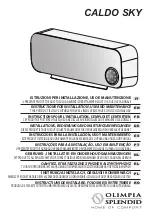
Recommended Propane Gas Supply
Average Temp º F/ºC
50/10 40/4.4 30/-1.1 20/-6.7 10-12.2 0/-17.8 010/-23
Number of 100 lb.
TS080
1
1
2
2
2
2
2
/45 KG Cylinders to
Use Per Heater
TS170
2
2
3
3
3
3
3
* Cylinders must be manifolded together to allow simultaneous vapor withdrawal from all cylinders.
proper application of pipe compound before
further tightening.
-- Tighten the gas connections as necessary to
stop the leak.
-- After all connections are checked and any
leaks are stopped, turn on the main burner.
-- Stand clear while the main burner ignites to
prevent injury caused from hidden leaks that
could cause flashback.
-- With the main burner in operation, check all
connections, hose connections, fittings and
joints as well as the gas control valve inlet and
outlet connections with approved gas leak
detectors.
-- If a leak is detected, check the components
involved for cleanliness in the thread areas
and proper application of pipe compound
before further tightening.
-- Tighten the gas connection as necessary to
stop the leak.
-- If necessary, replace the parts or components
involved if the leak cannot be stopped.
-- Ensure all gas leaks have been identified and
repaired before proceeding.
9. A qualified service agency must check for proper
operating gas pressure upon installation of the
heater.
10. Light according to instructions on heater or within
owner's manual.
11. The heater must have the proper gas regulator for the
application. Use only the L.B. White regulator
originally supplied with the heater. This regulator
includes a POL fitting incorporating an excess flow
valve. The excess flow valve is a safety device which
protects against discharge from the propane gas
supply container if the regulator is broken off. If the
POL fitting is ever replaced, it needs to be replaced
with an L.B. White POL fitting. Failure to do so can
result in fires, explosions, loss of property, injury or
death.
12. A regulator must be connected to the gas supply so
that the pressure to the inlet of the gas control valve
is regulated within the range specified on the
dataplate at all times. Contact your gas supplier or
the L.B.white Co., if you have any questions.
13. This heater is configured for use for propane gas
vapor withdrawal only. Do not use the heater in an
propane gas liquid withdrawal system or application.
If you are in doubt, contact the L.B. White Co., Inc.
14. The heater must be installed so as not to interfere
with or obstruct normal exits, emergency exits, doors
and walkways.
15. Railing, fencing or suitable substitute materials must
be used to keep the heating equipment from any
people using and visiting the structure.
16. The unit shall be located so that rain, ice, or snow
drainage from the structure does not af fect
equipment operation. If the unit is mounted outside,
it must be mounted above any pooled or standing
water. If the unit is to be located on the ground, a
surrounding trench is recommended to drain any rain,
ice or snow away from the unit.
17. The ground and surrounding terrain must be cleared
of any combustible vegetation and other combustible
materials when the heater is mounted outside.
18. Eventually, like all electrical/mechanical devices, the
thermostat can fail. Thermostat failure may result in
an underheating condition. The thermostat should be
tested to make sure it turns the heater on and off
within a temperature differential of ±3°F (±1.5 °C).
19. Take time to understand how to operate and maintain
the heater by using this Owner’s Manual. Make sure
you know how to shut off the gas supply to the
building and also to the individual heater. Contact
your fuel gas supplier if you have any questions.
20. Any defects found in performing any of the service or
maintenance procedures must be eliminated and
defective parts replaced immediately. The heater
must be retested by properly qualified service
personnel before placing the heater back into use.
The vaporization of propane is affected by several factors:
the surface area of the container, the liquid level of
propane, temperature surrounding the container, and the
relative humidity. All of these factors are specific to a site.
Therefore, a degree of experience and judgement is
required to select the proper propane supply.
Although experience is the best guide, the following
recommendations can be used as a starting point. The
table is based on experience in northern climates where
cold weather and high humidity are prevalent in the winter.
If more or less favorable conditions prevail at a specific site,
adjustments can be made on the basis of experience.
8
PROPANE GAS SUPPLY SIZING
Summary of Contents for Premier TS080
Page 2: ......










































